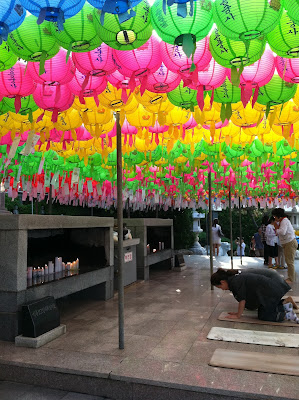Two things: I am an awful gorcery shopper. Also, it's raining. This is why I am sitting in my living room, looking out on the city of Gwangmyeong with a bowl of cereal for dinner, thankful that because of the rain I can enjoy the cool breeze of my door being open without mosquitos flying in.
 Lately I've been wondering how much longer the city will be comfortable for me. Plans, as they tend to do, have morphed into something I don't quite recognize yet. I've always, I think, preferred the complicated city where there's always something to do--always noise to out the noise in your head. Now I'm a new person, open to growing, accepting of who I am in this moment. In moments like this, with the hum of my lightbulbs and the patter of the rain, I can just barely make out a faint outline of this new life that might be waiting for me.
Lately I've been wondering how much longer the city will be comfortable for me. Plans, as they tend to do, have morphed into something I don't quite recognize yet. I've always, I think, preferred the complicated city where there's always something to do--always noise to out the noise in your head. Now I'm a new person, open to growing, accepting of who I am in this moment. In moments like this, with the hum of my lightbulbs and the patter of the rain, I can just barely make out a faint outline of this new life that might be waiting for me.
Before I left the states, many people were curious about this suspicious year gallavanting in a faraway land and were genuinely concerned about my "life plan", something, it seems, that is really only heard in America. In a sharp reaction to something someone said about "after Korea" I retorted that of course I'll come back to New York and persue a "real" career as soon as it's over. After Korea. To me and to this supposing stranger Korea seemed like magical land where time would be spent in a dream. As if I were leaving the world to go to Korea, and afterwards I'd re-emerge in some English-speaking metropolitis, hustling for the best job, apartment, and boyfriend in search of "success".
After two months here I find myself in what seems like some sort of drug-induced haze only because I'm writing this: I find myself questioning what it is that makes us who we are, and what we will become. Is it what we have, what we want, or what we need? I'm questioning not only who we are, but what it means to be happy.
.JPG) |
| Chungpyeong, where I realized that slowing down was kind of nice. |
I have an old, farily shitty, but full-of-character apartment in a suburb of Seoul, a job where I get to act like a kid, and a bunch of alcohol-loving friends. I want an endless adventure that's always stimulating me physically and mentally with someone who cares about the things I do but also challenges me, and a job that allows me--no, wants me--to seek that adventure. I need someone on the sidelines, telling me that it's all okay.
Korea is not some black hole where one magically reappears on the 365th day of their contract headed back home on a plane with some souveneirs. It's very, very real, and it took me two months but I have Korean classes I'm expected at, a boxing gym I belong to, a convenience store on my corner that recognizes me, but always speaks fluent Korean to me regardless as if I'll understand. A phone contract and a bank account. An alien registration card. I'm meeting people that are coming and going in and out of my life at an alarming rate. I'm suprising myself at just how much I'm capable of. I'm exploring relationships, messing them up, and figuring out how to (or whether I should) piece them together.
Ten months left of this particular contract to go, and I have no answers. There are no plans--only that faint outline that's forever morphing, depending on what angle I look at it from. At my highest, lowest, most shallow and most introspective the shape has yet to choose a set formation. And I'm left with only my thoughts, from the most abstract to the most mundane. And to those wondering about this so-called "after": it's okay. Turns out, there is no after, no fabled ending to try to arrive at, no specific dinner your supposed to have. If you have cereal, enjoy the cereal, and tommorrow is another day to learn, grow, and evolve.
.JPG)
.JPG)

.JPG)










.JPG)
.JPG)
.JPG)
.JPG)














